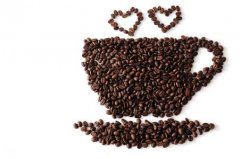The origin of caramelization of the attractive aroma of coffee

Why do you love coffee so much, in addition to caffeine and other effects, I think everyone and thousands of coffee fans often miss coffee because of its charming aroma, then how does this aroma come from? The important thing is that coffee beans are rich in a variety of raw materials, after roasting a variety of reactions, and create an attractive aroma. The two most important reactions are caramelization reaction and Mena reaction. Let's take a look at what these two reactions are all about.
1. caramelization reaction
The sugar content in coffee beans undergoes caramelization reaction at about 170~200℃, which is exactly the melting point of sucrose (185℃) and the temperature of the first explosion stage when coffee beans are roasted. The products of caramelization are divided into two parts:
(1)The dehydrated product of sugar, caramel or brown
(2)The cracking products are mainly volatile aldehydes and ketones.
In general, caramelization produces roasted aromas, caramels, and colors, as well as other aromatic compounds such as maltol, Cyclotene, furans, and so on, which can also be found in red wine, juice, cream, and other foods. However, if you caramelize too much during the roasting process, it is not a good thing. Instead, it will cause carbonization and make the coffee dry and bitter. If not caramelized enough, the aroma will be dull and lack of depth.
2. Maillard reaction
Menard reaction can be divided into three stages
1. Initial stage:
Amadori Molecular Rearrangement by Carbonylamine Condensation
II. Medium-term:
Amadori molecular rearrangement product fructosamine dehydration to HMF(hydroxymethylfurural), fructosamine deamination to reduce ketone, amino acid and dicarbonyl compounds.
III. Final Stage:
Aldol condensation, polymerization reaction to form melanin.
In addition to carbohydrates, proteins account for about 11% of the raw bean weight, and the amino acids contained in these proteins are just the raw materials for the Mena reaction. Menard reaction refers to a series of reactions between amino acids and reducing sugars (glucose, fructose, lactose, etc.) in food during heating. Mena reactions produce a wide variety of aromatic substances and pigments such as Pyridines, Pyrazines ,Oxazoles, Thiazoles, Pyrroles. Mena reaction plays an important role in the flavor of food cooking, whether it is sausage when grilling black and emitting flavor, crispy outside soft roast chicken, fragrant toast, these barbecue foods are behind the Mena reaction.
Coffee is blessed with a large and complex variety of chemicals, in addition to the above compounds, there are other organic acids, inorganic acids, plant alkaloids and so on. Not only sweet and beautiful ingredients, but also slightly bitter compounds give coffee a wider range of flavors and variations, creating a unique rich taste of coffee.
Do you know why coffee has such an attractive aroma? Do you miss coffee more?
Important Notice :
前街咖啡 FrontStreet Coffee has moved to new addredd:
FrontStreet Coffee Address: 315,Donghua East Road,GuangZhou
Tel:020 38364473
- Prev

Caffeine has positive effects on improving short-term and long-term memory
Coffee originated in western countries. In the United States, research shows that 80% of adults consume caffeine every day. Coffee is also a popular drink in the eyes of Chinese people. You or your friends and family may also drink coffee every day, but I think you may only know some superficial things about caffeine. For example, caffeine is found in coffee drinks and sodas.
- Next

How much do you know about coffee roasting? what are the characteristics of different roasting degrees?
Now more and more roasted coffee comes into people's lives, which seems to be more delicious than instant coffee, so do you know the degree of roasted coffee? What are the characteristics of different degrees of baking? From the point of view of the baking degree, the deeper the baking degree, the stronger the bitter taste; the lighter the baking degree, the stronger the sour taste. The choice of baking degree depends on the characteristics of the coffee bean itself, which is bitter.
Related
- Detailed explanation of Jadeite planting Land in Panamanian Jadeite Manor introduction to the grading system of Jadeite competitive bidding, Red bid, Green bid and Rose Summer
- Story of Coffee planting in Brenka region of Costa Rica Stonehenge Manor anaerobic heavy honey treatment of flavor mouth
- What's on the barrel of Blue Mountain Coffee beans?
- Can American coffee also pull flowers? How to use hot American style to pull out a good-looking pattern?
- Can you make a cold extract with coffee beans? What is the right proportion for cold-extracted coffee formula?
- Indonesian PWN Gold Mandrine Coffee Origin Features Flavor How to Chong? Mandolin coffee is American.
- A brief introduction to the flavor characteristics of Brazilian yellow bourbon coffee beans
- What is the effect of different water quality on the flavor of cold-extracted coffee? What kind of water is best for brewing coffee?
- Why do you think of Rose Summer whenever you mention Panamanian coffee?
- Introduction to the characteristics of authentic blue mountain coffee bean producing areas? What is the CIB Coffee Authority in Jamaica?

